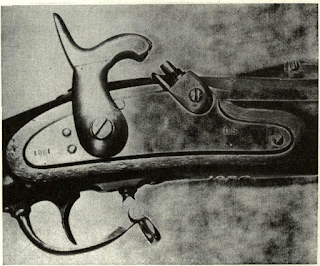Second in importance to the British Enfields to both
Graded as arms of the second class by the U. S.
Rifle muskets, Austrian, leaf sight, quadrangular
bayonet ...............................Caliber .59
Rifle muskets, Austrian, leaf sight, quadrangular
bayonet ...............................Caliber .58
Rifle muskets, Austrian, block sight, quadrangular
bayonet ...............................Caliber .58
Rifle muskets, Austrian, leaf sight, quadrangular
bayonet ...............................Caliber .57
Rifle muskets, Austrian, block sight, quadrangular
bayonet ...............................Caliber .577
Rifle muskets, Austrian, quadrangular bayonet ..Caliber .55
All these weapons were of one basic pattern, newly
Calibers between .59 and .54 existed because these
The quadrangular bayonet is a clasp type similar
Aside from calibers, only one of which is the
Graded as arms of the second class by the U. S.
Rifle muskets, Austrian, leaf sight, quadrangular
bayonet ...............................Caliber .59
Rifle muskets, Austrian, leaf sight, quadrangular
bayonet ...............................Caliber .58
Rifle muskets, Austrian, block sight, quadrangular
bayonet ...............................Caliber .58
Rifle muskets, Austrian, leaf sight, quadrangular
bayonet ...............................Caliber .57
Rifle muskets, Austrian, block sight, quadrangular
bayonet ...............................Caliber .577
Rifle muskets, Austrian, quadrangular bayonet ..Caliber .55
| Springfield rifle copy believed imported by William Hahn is dead ringer for U.S. regulation rifle but it is not known if |
All these weapons were of one basic pattern, newly
Calibers between .59 and .54 existed because these
 |
| German-made Springfield rifle in West Point Museum bears |
The quadrangular bayonet is a clasp type similar
Aside from calibers, only one of which is the

Comments
Post a Comment